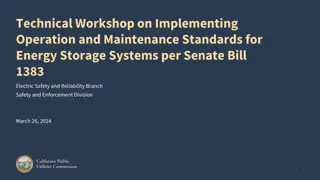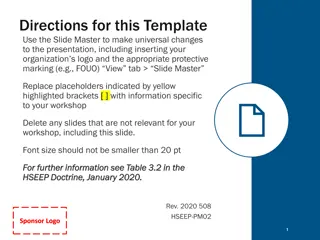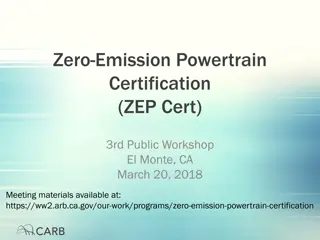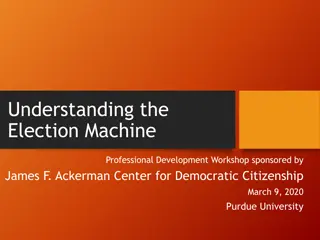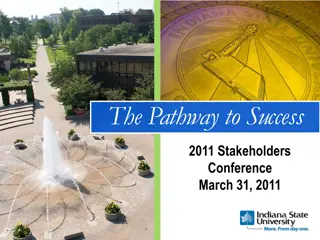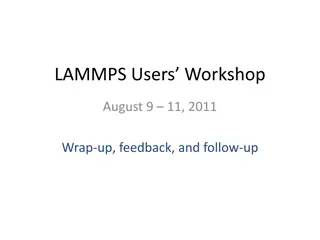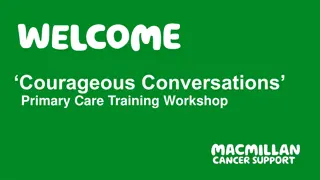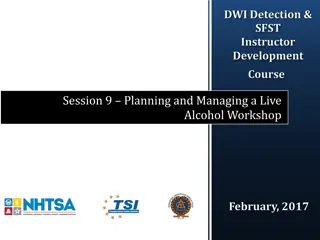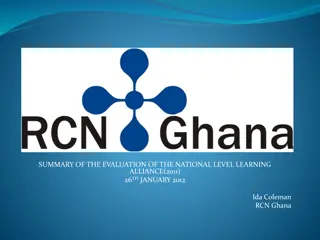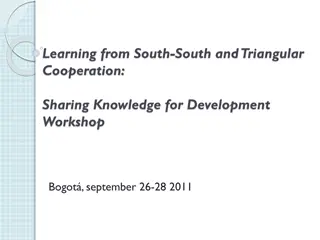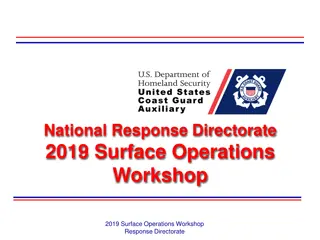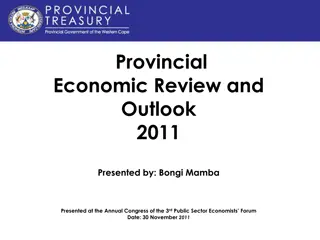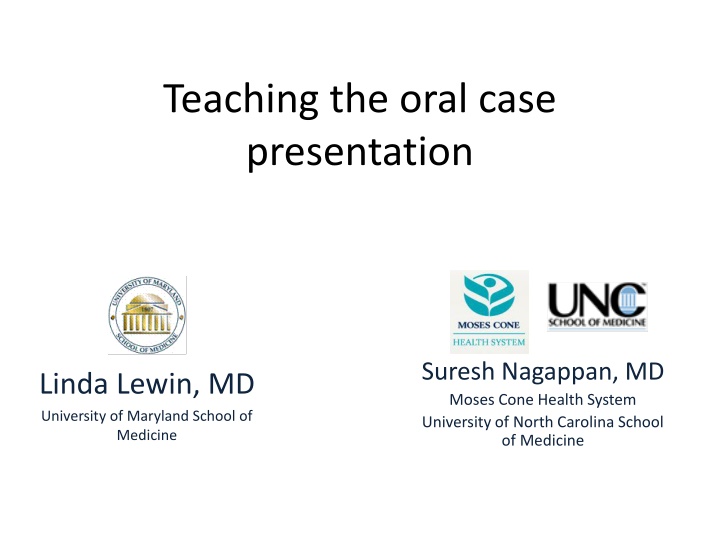
Teaching Effective Oral Case Presentation Skills in Medical Education
Explore a comprehensive workshop designed to enhance medical students' oral case presentation abilities, addressing common challenges such as long, unfocused presentations and lack of formal instruction. Gain insights on developing curriculum, assessment tools, and strategies for providing specific feedback in clinical settings.
Download Presentation

Please find below an Image/Link to download the presentation.
The content on the website is provided AS IS for your information and personal use only. It may not be sold, licensed, or shared on other websites without obtaining consent from the author. If you encounter any issues during the download, it is possible that the publisher has removed the file from their server.
You are allowed to download the files provided on this website for personal or commercial use, subject to the condition that they are used lawfully. All files are the property of their respective owners.
The content on the website is provided AS IS for your information and personal use only. It may not be sold, licensed, or shared on other websites without obtaining consent from the author.
E N D
Presentation Transcript
Teaching the oral case presentation Suresh Nagappan, MD Moses Cone Health System University of North Carolina School of Medicine Linda Lewin, MD University of Maryland School of Medicine
Introductions http://www.exhibitoronline.com/exhibitormagazine/images/MARCH_2004/MARCH_schmooze/handshakelarge.jpg What is your experience with teaching the oral case presentation?
The workshop Part I Curriculum 1:40 pm A brief description of a curriculum for teaching medical students how to give complete/concise Oral Case Presentation (OCPs) 1:50 pm Using sample H&Ps, participants identify the important content that they would want a student to present. A consensus document will be created an emailed to the group after the session. 2:00 pm Participants work in small groups to develop learning objectives and teaching methods for a curriculum in giving OCPs 2:20 pm Groups report briefly on their work and workshop leaders create a master list of objectives and methods to distribute to participants Part II Assessment 2:30 pm Participants listen to an actual third year student OCP and share their impressions and the feedback they would give to the student 2:40 pm Presenters describe one oral case presentation rating tool and its development, and then review how it is used 2:50 pm Participants use the rating tool as they re-listen to the same OCP 3:00 pm Presenters facilitate a large group discussion about how the rating tool affected the way that they listened to the presentation, the feedback they would give, the strengths and weaknesses of the tool, and how that tool could be improved and used across a variety of clinical settings
The Problem Medical student oral case presentations on rounds can be long, unfocused, and miss key information
The Problem Students are often adept at reporting, but not as good at interpreting They sometimes lapse into simply reading off their H&P At our institution, there is little formal instruction on delivering oral presentations Students transitioning into their clinical years are more anxious about their oral presentation abilities than any other skill. Presenting on rounds is high stakes for students and an important part of their evaluation
The Problem Immediate, specific feedback after each presentation is best but hard to do Often, students end up hearing be more concise or leave out the irrelevant parts, but without enough specifics to be constructive
The Intervention An hour long interactive session at the beginning of the clerkship in which students practice presentation skills Meant to be a supplement to, not a replacement for, continual feedback and practice with reflection
The Intervention Faculty who attend on the inpatient service at Moses Cone Hospital and at University of North Carolina Hospital reviewed sample H&Ps Each attending reviewer highlighted only phrases they felt were most pertinent and should be presented on rounds
The Intervention Reviewers made a notation if they wanted a phrase to be moved to another part of the presentation. A consensus document was created based on the responses. Phrases that were highlighted by the majority of the reviewers were included in the consensus document
The Intervention Students review the same sample H&Ps on common pediatric issues (bronchiolitis, gastroenteritis) Students underline or highlight phrases from the H&Ps that they think should be presented orally, leaving blank phrases that can be omitted Students each present a case A detailed discussion follows in which the group compared their presentations with the faculty consensus document. The students were then encouraged to practice this skill during inpatient rounds.
Sample H&Ps There are 2 sample student H&Ps. Underline or highlight the phrases that you would want a third year student to present orally on rounds. You can add summary statements e.g., non- contributory You can indicate if a phrase should be moved to another section
Small Groups Developing a plan for a potential Oral Case Presentation curriculum Consider: Learning Objectives Teaching Methods (what kind of intervention?) Teaching Materials Opportunity to practice new skills
Rating Oral Case Presentations The other side of the same coin
The problem As previously mentioned: Reporter vs. Interpreter Want students to know their patients not just to read their write-ups Need immediate and specific feedback Want convenient evaluation tool that includes clinical reasoning as a core element
How do you do this? Who rates the presentations? What format? What kind of feedback? What affect on students grades? Want to share? llewin@peds.umaryland.edu
Listen to this! What feedback would you give?
Development of A Tool with Interpretation in Mind Review of published tools Identification of most important elements by focus groups of educators across disciplines Creation of first draft 16 items in 3 categories Overall rating at the end of each category and and of tool
Study #1 IRB approval received 15 presentations recorded Three raters rated each Correlation studied (inter-rater reliability) No correlation found
Problems Noted by Raters Hard to rate the reporter and interpreter functions at the same time No place to indicate specific questions Some items too wordy
Tool Revised Interpretation items moved to the end Place for comments added All wording simplified New Tool Studied Two new raters and one repeat Preliminary results show better correlation
University of Maryland OCP Rating Tool History Chief complaint/introduction Clear chronology of events PMH, FH, SH, ROS elements relate to active problems Physical/diagnostic tests General statement Vitals/growth parameters Targeted physical exam Diagnostic testing that clarifies ddx
University of Maryland OCP Rating Tool Summary statement important distinguisher of clinical reasoning Assessment/Plan Prioritized problem list Ddx for each problem Plan for each problem Clinical reasoning/synthesis All pertinent positives and negatives included Painted a clear picture of the patient
University of Maryland OCP Rating Tool General aspects Overall organization Speaking style Able to answer questions Overall assessment
Discussion Did you listen differently? Would you give feedback differently? What was good about the tool? What should be changed? How could this tool be incorporated into your busy clerkships?


